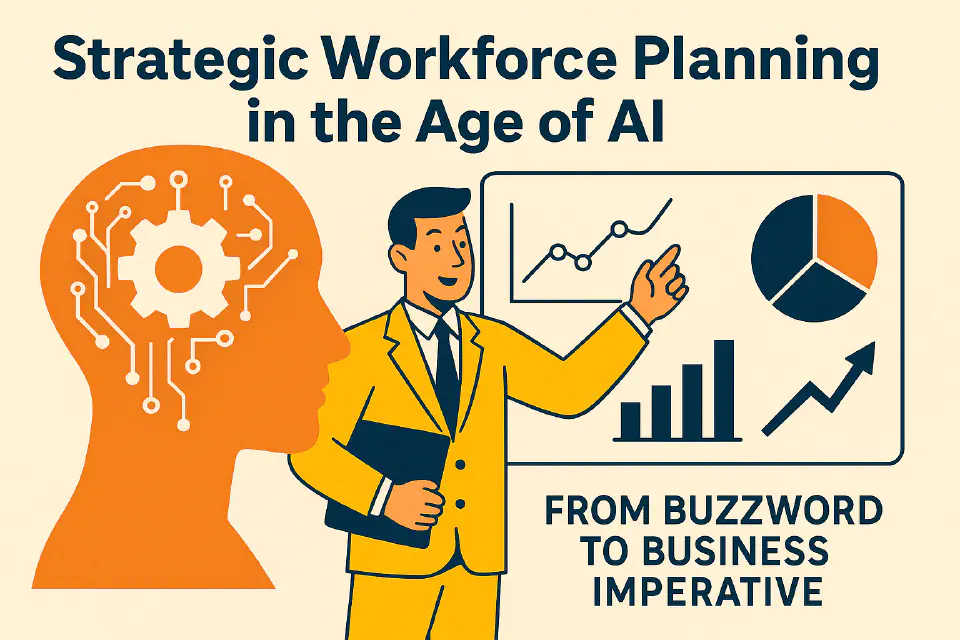
Strategic Workforce Planning in the Age of AI: From Buzzword to Business Imperative
Strategic workforce planning is no longer optional. In an era of AI disruption and shifting skills, organizations that treat talent like capital—and plan accordingly—are the ones that thrive.
Strategic workforce planning (SWP) used to live in the realm of PowerPoint decks, HR offsites, and five-year visions nobody looked at again. But those days are gone. Today, with generative AI transforming job roles overnight and entire industries realigning their talent needs, SWP has become a board-level priority.
According to McKinsey, companies that optimize their return on talent generate 300% more revenue per employee than their peers. That’s not an HR metric—it’s a bottom-line imperative.
Let’s unpack what makes strategic workforce planning not just useful, but mission-critical in the age of AI. And more importantly, how forward-thinking organizations are using it to gain agility, build capabilities, and stay ahead of change.
From Annual Exercise to Real-Time Intelligence
For years, SWP was treated like an annual ritual—conducted by HR in spreadsheets and rarely consulted after budget approval. But that approach can’t keep up with a world where skills become obsolete faster than job titles change.
Modern SWP is about agility. It requires linking HR, finance, and operations to:
- Forecast talent needs across multiple scenarios
- Match current capabilities to future demands
- Make dynamic, real-time talent allocation decisions
It’s not about predicting the future. It’s about being ready for multiple possible futures.
Best Practice #1: Treat Talent as Strategic Capital
In high-performing organizations, workforce decisions are made with the same rigor as capital investments. Why? Because talent is your biggest value driver—and your biggest constraint.
Take the example of an Asian manufacturing giant: they had the financial capacity to build three new plants. But after running SWP alongside financial modeling, they chose to build only two—because talent capacity would not support more.
The result? Strategic pacing of growth, better onboarding, and long-term sustainability.
Best Practice #2: Build Capabilities, Not Just Headcount
One of the most common mistakes in workforce planning is focusing solely on capacity—how many people you’ll need. But the real magic happens when you map out capabilities—what those people need to be able to do.
A Middle Eastern city wanted to become a knowledge economy. Their SWP revealed that they lacked both data on critical roles and visibility into future skills demand. They created an analytics-based human capital outlook and developed a scenario model for inflows, outflows, and talent gaps.
Suddenly, they could see the future—and plan for it.
Best Practice #3: Model Multiple Scenarios—Not Just One
Planning for a single future is like building a house on a fault line without earthquake insurance. Smart organizations run multiple scenarios, especially in functions likely to be disrupted by AI or automation.
A North American software company used SWP to assess the impact of Gen AI on their product and engineering roles. They:
- Identified internal Gen AI use cases
- Modeled productivity gains by role
- Created plans for redeployment and upskilling
- Froze or cancelled non-core projects to redirect talent
This allowed them to pivot fast, without layoffs or panic.
Best Practice #4: Expand the Talent Lens Beyond Recruiting
Too many companies treat external hiring as the only solution to skills gaps. But in today’s market, the talent you need might not exist at scale—or might be too expensive to attract.
A global telco wanted to lead the 5G race. But instead of chasing scarce external profiles, they built a “future of work” hub and mapped internal talent to 5G-critical roles. Then they launched tailored learning journeys and used advanced analytics to forecast capacity.
The result? Fewer recruiting costs, faster time to productivity, and higher employee engagement.
In another innovative move, a large media company started retaining rejected applicants in a talent pool and used Gen AI to match them to new roles over time. This reduced time-to-hire and improved candidate experience—while creating a sustainable advantage.
Best Practice #5: Make SWP a Business-as-Usual Process
SWP should not be a project. It should be a core business capability. That means:
- Embedded in operating rhythms (not just HR calendars)
- Owned jointly by HR, Finance, and Business leaders
- Supported by tools, dashboards, and change management
- Tied to KPIs, bonuses, and performance metrics
One European energy utility rolled out SWP across five business units, building future role taxonomies, forecasting models, and intervention templates. Within a year, it had a scalable, repeatable model that linked talent to business strategy across the enterprise.
Key Enablers: What You Need to Make It Work
To embed SWP successfully, organizations need four foundational elements:
1. Robust Talent Data Infrastructure
This includes headcount, skills inventory, performance metrics, attrition trends, and external benchmarks. The goal is to move from anecdotes to analytics.
2. Strong Governance and Ownership
Whether SWP sits under HR or Finance, it must have executive sponsorship and business buy-in. Without this, it becomes another HR report with no teeth.
3. Scenario-Based Tools and Dashboards
These tools should allow leaders to explore “what if” situations, test interventions, and visualize workforce supply vs. demand across time horizons.
4. Change Management and Capability Building
Most managers aren’t trained to think in workforce planning terms. They need support, training, and success stories to internalize the mindset.
Final Thought: From Forecasting to Futures Thinking
Strategic workforce planning isn’t about being right. It’s about being ready. In the age of AI, talent models will break. Roles will disappear. New ones will emerge.
Organizations that embed SWP into the fabric of their business—not as a spreadsheet but as a decision-making muscle—will thrive in this volatility.
SWP is how you go from guessing to knowing. From reacting to leading.
And in this AI age, it might just be the most important thing HR does.